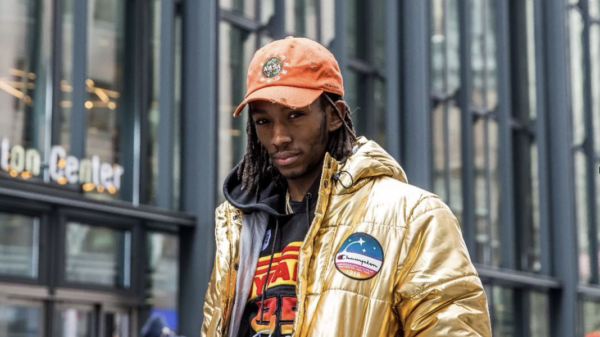Before Lollapalooza became just another giant festival, it was a culture-shaking Nineties traveling carnival that helped define the thing we used to call “alternative.” Key moments in the careers of Pearl Jam, Nine Inch Nails, Ice-T, Green Day, Rage Against the Machine, Courtney Love, and many more played out on its stages, as chronicled in the excellent new oral-history book Lollapalooza: The Uncensored Story of Alternative Rock’s Wildest Festival.
In the new episode of Rolling Stone Music Now, authors Tom Beaujour and Richard Bienstock break down some of the wildest Lolla stories from their book. To hear the whole episode, go here for the podcast provider of your choice, listen on Apple Podcasts or Spotify, or just press play above. Here are some highlights from the discussion:
Co-founder Perry Farrell’s original vision included a bizarre communal food experience. For some reason, the Jane’s Addiction frontman was obsessed with the idea of a giant burrito that all festival-goers would share. “It’s truly the most prodigious health hazard you could think of,” Beaujour says, “but that was what he was really going for.”
It would be impossible to put on an affordable traveling festival in 2025. “Although it was a huge thing for 10 years, the touring festival is now gone again,” Beaujour says. “According to the Lollapalooza founders, who are still booking agents, there’s no universe, given what bands get paid, where the tickets aren’t like $2,800.”
It’s easy to forget that until 1996’s run with Metallica, most Lollapaloozas took place in amphitheaters with assigned seating — a truly bizarre setting for a festival. “It plagued them all the way through,” says Beaujour. “The bands that went on early were playing in front of reserved seats that were not full, and did not have great experiences. They were playing to, like, nine people in front, and then the kids who are the super music fans up on the lawn in back having a great time…. They kind of had to do it that way because they needed to go into places that had the infrastructure.”
Editor’s picks
Jane’s Addiction fell apart possibly for good onstage last year, but the same thing nearly happened at the very first date of the 1991 Lollapalooza tour — which Farrell had already conceived as a farewell tour for the band. “Dave Navarro and Perry come to blows day one of the festival,” Bienstock says. “Who knew if they’ were even gonna have day two? But they managed to right the ship… Dave Navarro [told us], I didn’t even know that it was a Jane’s Addiction farewell tour. He was like, ‘I thought we were just touring!’”
Nine Inch Nails delivered career-defining performances at the 1992 festival — but on night one, their equipment literally melted in hot weather, cutting their show short early. “They literally plugged all of their backing tracks and equipment into one electrical outlet,” says Beaujour.
The 1992 festival faced logistical nightmares when Pearl Jam’s popularity exploded between booking and touring — and the band was slotted to play in early afternoon. “By the time they’re on Lollapalooza, they’re literally becoming the biggest band in the world,” Beaujour says. Organizers faced the daunting challenge of getting the entire crowd into the venue so early in the day, and security concerns became paramount, he adds: “They knew that if Pearl Jam started and they didn’t have the kids in the venue, that the fences were coming down…. They were also given the opportunity to move up the bill actually, and chose not to because of, I guess, punk rock.” Eddie Vedder was still enjoying himself on the road at that point, even spending time with the freak-show performers from the Jim Rose Circus Sideshow: he even drank stomach bile and shoved his face into broken glass.
Butthole Surfers‘ Gibby Haynes brought a shotgun, loaded with blanks, on stage. “Blanks will still take off your head at like 10 feet,” Beaujour says. “And he would come out and chastise the audience for not having rocked out hard enough to the Rollins Band and then just shoot the gun over the audience, which is so impossible to conceive of in this day and age.”
Related Content
If not for Kurt Cobain‘s 1994 overdose in Rome and subsequent suicide, Nirvana definitely would’ve headline Lollapaooza that year.. “The ink was dry on the contracts,” Bienstock says. basically, and they were doing this thing,” Bienstock reveals. Even so, Beaujour adds, “’94 is really for me, the sweet spot,” adds Beaujour. “Between Beastie Boys, and the Breeders on the main stage and L7 combined with the big arena rock of Smashing Pumpkins and Green Day, they threaded the needle that year.”
Perry Farrell tried to block Green Day from that year’s line-up because he somehow became convinced they were an actual boy band assembled by their record label. “Billie Joe Armstrong was super bummed out because they love Jane’s Addiction,” Beaujour says. “The first minute of the interview, he is just like, ‘Perry was just being a straight up dick.’”
Smashing Pumpkins’ Billy Corgan rubbed other performers the wrong way that year. “Wayne Coyne calls him a ‘raging asshole,’” says Bienstock. “He is like, ‘If I see that guy nowadays backstage somewhere, I’m just turning around walking the other way.’”
Sonic Youth‘s 1995 headlining stint didn’t go over well. “The kids were not at all interested in seeing Sonic Youth,” Beaujour says. “1995 with Sonic Youth headlining is also the worst office year of Lollapalooza.” In the book. Thurston Moore says it “definitely teetered on Spinal Tap playing at the theme park.”
Courtney Love’s behavior during the 1995 tour, which included throwing a punch at Bikini Kill’s Kathleen Hanna, reflected her difficult personal circumstances. “This is not long after Kurt’s death,” Bienstock says. “She should not have been out on the road.” Her road manager provided important context: “There is no way in heaven that in 2025, somebody in the mental condition that Courtney Love was in would be allowed to tour.” Even so, one other performer managed to freak out even Love: She told friends that Sinead O’Connor was “nuts.”
Trending Stories
Perry Farrell was furious over Metallica’s inclusion in 1996. “Perry quit the whole tour in protest,” says Bienstock.
The British band James had an extremely rough time playing right before Korn in 1997, facing nonstop heckling, even if Korn themselves loved them. ”The arrival of Korn really was the end of alternative rock and the beginning of nü metal,” Beaujour says. “It brings in that massive Korn crowd who are really just there for that and to go nuts. It makes them incredibly hostile to the other bands.”
Download and subscribe to Rolling Stone‘s weekly podcast, Rolling Stone Music Now hosted by Brian Hiatt, on Apple Podcasts or Spotify (or wherever you get your podcasts). Check out eight years’ worth of episodes in the archive, including in-depth interviews with Mariah Carey, Bruce Springsteen, SZA, Questlove, Halsey, Neil Young, Snoop Dogg, Brandi Carlile, Phoebe Bridgers, Rick Ross, Alicia Keys, the National, Ice Cube, Taylor Hawkins, Willow, Keith Richards, Robert Plant, Dua Lipa, Killer Mike, Julian Casablancas, Sheryl Crow, Johnny Marr, Scott Weiland, Liam Gallagher, Alice Cooper, Fleetwood Mac, Elvis Costello, John Legend, Donald Fagen, Charlie Puth, Phil Collins, Justin Townes Earle, Stephen Malkmus, Sebastian Bach, Tom Petty, Eddie Van Halen, Kelly Clarkson, Pete Townshend, Bob Seger, the Zombies, and Gary Clark Jr. And look for dozens of episodes featuring genre-spanning discussions, debates, and explainers with Rolling Stone’s critics and reporters.



























